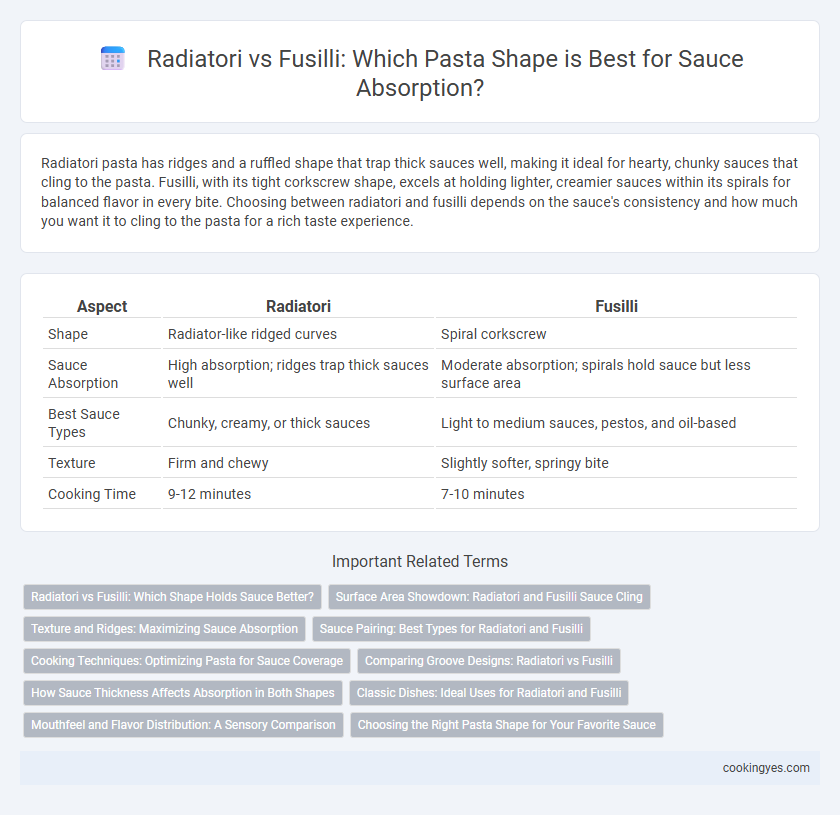Radiatori pasta has ridges and a ruffled shape that trap thick sauces well, making it ideal for hearty, chunky sauces that cling to the pasta. Fusilli, with its tight corkscrew shape, excels at holding lighter, creamier sauces within its spirals for balanced flavor in every bite. Choosing between radiatori and fusilli depends on the sauce's consistency and how much you want it to cling to the pasta for a rich taste experience.
Table of Comparison
| Aspect | Radiatori | Fusilli |
|---|---|---|
| Shape | Radiator-like ridged curves | Spiral corkscrew |
| Sauce Absorption | High absorption; ridges trap thick sauces well | Moderate absorption; spirals hold sauce but less surface area |
| Best Sauce Types | Chunky, creamy, or thick sauces | Light to medium sauces, pestos, and oil-based |
| Texture | Firm and chewy | Slightly softer, springy bite |
| Cooking Time | 9-12 minutes | 7-10 minutes |
Radiatori vs Fusilli: Which Shape Holds Sauce Better?
Radiatori pasta, with its ridged, radiator-like shape, offers superior sauce absorption compared to fusilli, whose spiral form primarily captures sauce on its outer curls. The deep grooves and compact, layered design of radiatori trap thicker sauces and chunky ingredients effectively, enhancing every bite with flavor. Fusilli performs well with lighter, oil-based sauces but lacks the dense surface area of radiatori for thick, hearty sauces.
Surface Area Showdown: Radiatori and Fusilli Sauce Cling
Radiatori pasta features tightly coiled, radiator-like ridges that create a substantial surface area, enhancing its ability to cling to thick, chunky sauces. Fusilli, with its spiral shape, offers a continuous twisted surface that traps sauce within its grooves, maximizing flavor retention. When comparing surface area for sauce absorption, radiatori's intricate ridges provide superior texture grip, while fusilli's spirals ensure even sauce coverage and retention in each bite.
Texture and Ridges: Maximizing Sauce Absorption
Radiatori pasta features tight, ruffled ridges and a compact, spiral-shaped texture that excels at trapping thick sauces, enhancing every bite with rich flavor. Fusilli, characterized by its longer, screw-like twists, provides a looser texture that allows lighter sauces to cling effectively without overwhelming the palate. Radiatori's dense ridges maximize sauce retention for creamy or chunky sauces, while fusilli's elongated spirals suit smoother, oil-based dressings.
Sauce Pairing: Best Types for Radiatori and Fusilli
Radiatori's ridged, radiator-like shape excels at trapping thick, chunky sauces such as meat ragu or creamy cheese sauces, making every bite rich and flavorful. Fusilli's spiral design is ideal for lighter, oil-based or tomato sauces that cling to their curves without overwhelming the pasta's texture. Both radiatori and fusilli pair well with pesto and vegetable-based sauces, but radiatori works best with hearty, slower-cooked sauces due to its robust surface area.
Cooking Techniques: Optimizing Pasta for Sauce Coverage
Radiatori's ridged, radiator-like shape creates deep grooves that trap thick sauces effectively, making it ideal for chunky or creamy preparations. Fusilli's spiral design twists sauce within its curves, promoting even coverage but sometimes allowing thinner sauces to slide off more easily. Cooking techniques like al dente boiling and finishing pasta in the sauce further enhance sauce adhesion for both shapes, maximizing flavor absorption.
Comparing Groove Designs: Radiatori vs Fusilli
Radiatori pasta features tight, radiator-like grooves that excel at trapping thicker, chunkier sauces, enhancing flavor retention with every bite. Fusilli's spiral ridges create multiple channels, effectively holding lighter, oil-based sauces and allowing for more even distribution. The design difference between Radiatori's compact grooves and Fusilli's elongated spirals directly impacts sauce adherence, making Radiatori ideal for dense sauces and Fusilli better suited for smooth, thin sauces.
How Sauce Thickness Affects Absorption in Both Shapes
Radiatori's ridged, radiator-like shape traps thicker sauces more effectively than fusilli, allowing each bite to hold rich, creamy, or chunky textures. Fusilli's spiral twists perform well with smoother, lighter sauces that cling to the pasta's curves but may not capture denser sauces as thoroughly. Sauce viscosity plays a crucial role; thicker sauces adhere better to radiatori's intricate ridges, while thinner sauces glide smoothly along fusilli's spirals.
Classic Dishes: Ideal Uses for Radiatori and Fusilli
Radiatori's ridged, radiator-like shape excels at trapping thick sauces such as pesto, meat ragu, or creamy tomato, making it ideal for hearty classic dishes like pasta bolognese or rich Alfredo. Fusilli's spiral design provides excellent sauce adherence for lighter, oil-based sauces, and it's commonly used in pasta salads or simple garlic and olive oil recipes. Both shapes enhance flavor absorption differently, with radiatori favoring chunky, rustic sauces and fusilli complementing smooth or vegetal-based sauces.
Mouthfeel and Flavor Distribution: A Sensory Comparison
Radiatori pasta's ridged, radiator-like shape excels in holding chunky sauces, creating an intense flavor burst with each bite due to its textured surface enhancing sauce clinging. Fusilli's spiral design efficiently traps smoother sauces, providing a balanced mouthfeel with even flavor distribution throughout. Sensory experiences favor radiatori for bold, sauce-heavy dishes, while fusilli suits lighter, cream-based sauces that demand gentle coating and consistent taste.
Choosing the Right Pasta Shape for Your Favorite Sauce
Radiatori pasta's ridged, radiator-like shape provides excellent surface area and grooves that trap thicker sauces, making it ideal for hearty meat or vegetable-based sauces. Fusilli's spiral form effectively holds lighter, creamy, or tomato-based sauces within its twists, enhancing flavor distribution. Selecting radiatori or fusilli depends on sauce texture, with radiatori optimizing absorption of chunky sauces and fusilli better complementing smoother, lighter options.
Radiatori vs fusilli for sauce absorption Infographic

 cookingyes.com
cookingyes.com